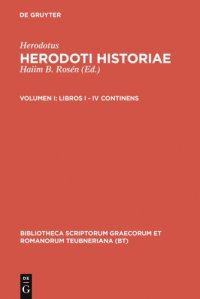
Ebook: Herodoti Historiae, Vol. I: Libros I-IV Continens
Author: Haiim B. Rosén
- Series: Bibliotheca Scriptorum Graecorum et Romanorum Teubneriana
- Year: 1987
- Publisher: Walter de Gruyter
- Language: Ancient greek and latin
- pdf
At long last Stein's text of Herodotus has been superseded. First published completely in 1869—1871 and revised in 1888, this text remained the standard for a century, despite the appearance of Hude's OCT, especially the third edition of 1927, and of Legrand's Bude. Both these later texts, though excellent in their own way, could not compare with Stein's work in thoroughness. But Haiim Rosén's new Teubner
text, Herodoti Historiae, is a landmark in the critical study of Herodotus' text: it is just the kind of update which Stein would probably do if he were alive today. The result is an awesome piece of scholarship and a quantum leap over Dietsch and Kallenberg's old Teubner text (first edition, 1855, third edition, 1933), which was never in any sense an adequate critical text.
In comparing Rosén's work to Stein's, it was deliberately drawn a parallel which can be helpful in judging the new text. Both in its inspiration and in its execution, Rosén's text is a continuation of the Steinian model of textual editing. Rosén even uses the same format, dividing his apparatus criticus into two parts and relying on Stein for citations of the secondary tradition. A comparison of the two texts shows that the new one is a greatly expanded version of the old one. There are significant differences of course (and in some ways Rosén has betrayed his master), but the general likeness is enough to establish the line of descent. This question then presents itself: How has Rosén adapted his Steinian model to his own purposes? In answering this question, it was come to the conclusion that what looks like a nineteenth-century text is actually a denial of editing as it is generally conceived, at least by most classicists. Despite its outward appearance, the new text is a philosophical exercise in empiricism, not substantialism, or the Ur-text.
text, Herodoti Historiae, is a landmark in the critical study of Herodotus' text: it is just the kind of update which Stein would probably do if he were alive today. The result is an awesome piece of scholarship and a quantum leap over Dietsch and Kallenberg's old Teubner text (first edition, 1855, third edition, 1933), which was never in any sense an adequate critical text.
In comparing Rosén's work to Stein's, it was deliberately drawn a parallel which can be helpful in judging the new text. Both in its inspiration and in its execution, Rosén's text is a continuation of the Steinian model of textual editing. Rosén even uses the same format, dividing his apparatus criticus into two parts and relying on Stein for citations of the secondary tradition. A comparison of the two texts shows that the new one is a greatly expanded version of the old one. There are significant differences of course (and in some ways Rosén has betrayed his master), but the general likeness is enough to establish the line of descent. This question then presents itself: How has Rosén adapted his Steinian model to his own purposes? In answering this question, it was come to the conclusion that what looks like a nineteenth-century text is actually a denial of editing as it is generally conceived, at least by most classicists. Despite its outward appearance, the new text is a philosophical exercise in empiricism, not substantialism, or the Ur-text.
Download the book Herodoti Historiae, Vol. I: Libros I-IV Continens for free or read online
Continue reading on any device:

Last viewed books
Related books
{related-news}
Comments (0)